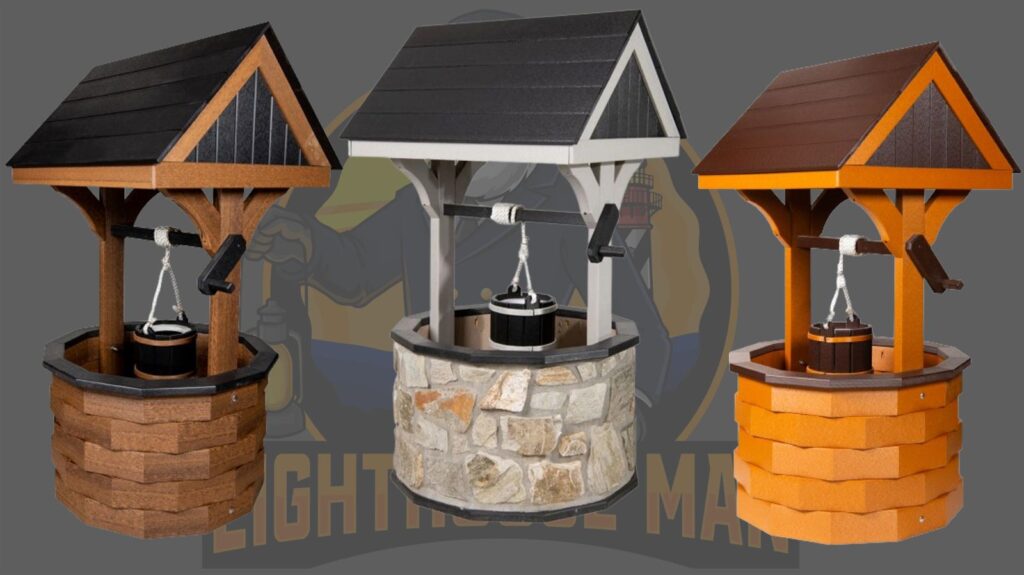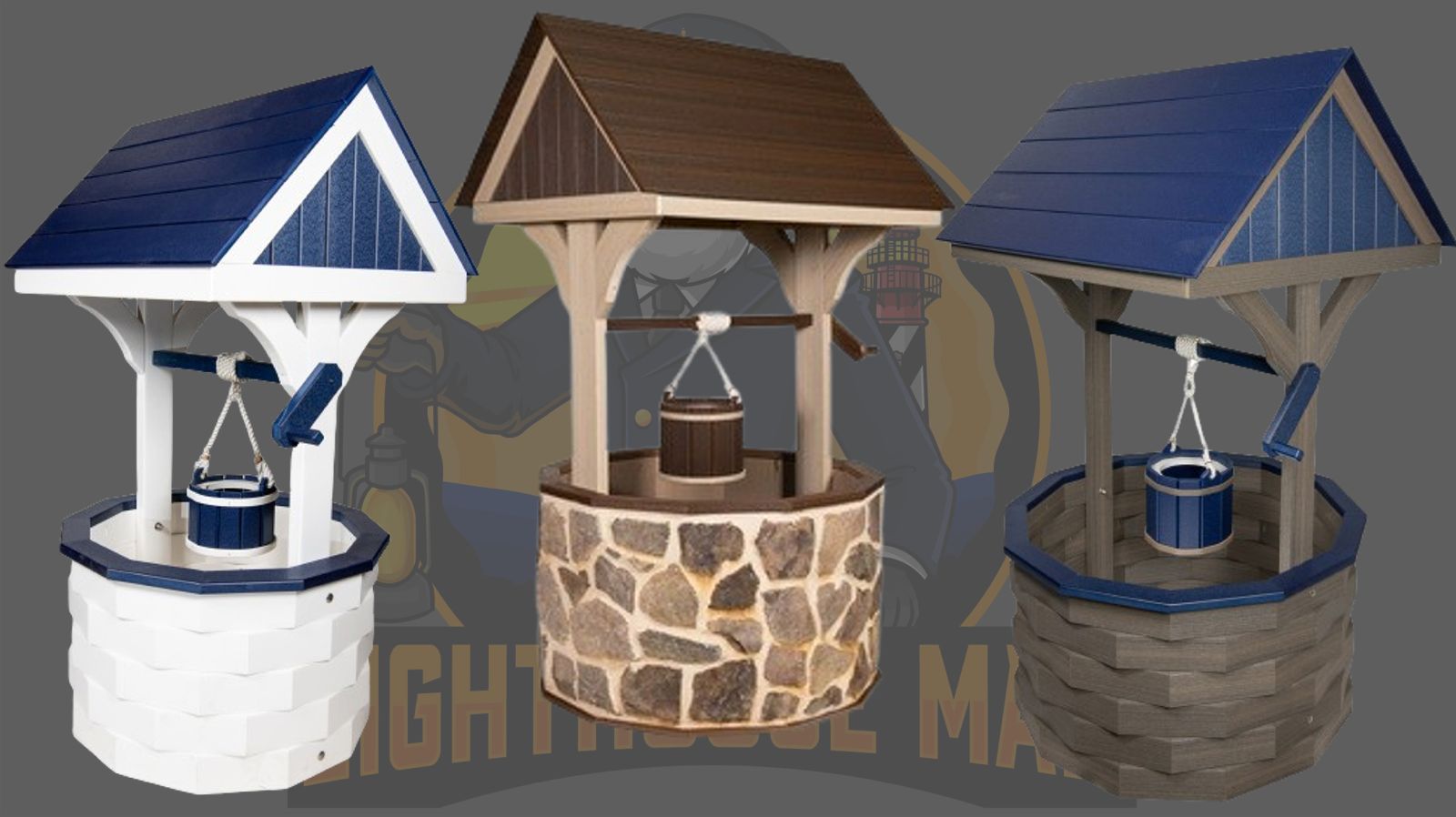When it comes to adding charm, whimsy, and a sense of magic to your outdoor space, Lawn and Garden Wishing Wells are a fantastic option. These timeless garden features can transform any landscape, whether large or small, by serving as a captivating focal point. However, before investing in one, it’s important to understand what factors to consider to ensure you select the perfect wishing well for your garden. From material choices to design and placement, this guide will help you make an informed decision when buying Lawn and Garden Wishing Wells.
Why Invest in a Lawn and Garden Wishing Well?
A Lawn and Garden Wishing Well offers several benefits beyond just being a decorative feature. These charming structures have the power to elevate the look and feel of your outdoor space.
- Aesthetic Appeal: A wishing well adds a unique, rustic touch to any garden, blending well with various landscaping styles, from country gardens to more contemporary designs. It can become a striking centerpiece, drawing attention and admiration.
- Symbolism: Traditionally, wishing wells are thought to bring good luck and fulfill wishes. The inclusion of a wishing well can bring a sense of serenity, hope, and positivity to your garden.
- Versatility: Wishing wells are incredibly versatile and can be used in numerous ways. Beyond decoration, they can function as small storage units, water features, or even focal points for planting flowers and climbing vines.
- Long-Term Investment: A high-quality wishing well made from durable materials can last for decades, providing long-term value and aesthetic enhancement to your garden.
What to Consider When Buying a Lawn and Garden Wishing Well
When purchasing a Lawn and Garden Wishing Well, there are several factors to consider to ensure it fits seamlessly into your landscape and meets your needs. Let’s dive into the key considerations that will guide your purchase.
Material Choices
The material of your wishing well plays a huge role in its appearance, durability, and maintenance. Here are some of the most common materials used in Lawn and Garden Wishing Wells:
- Wood: Wooden wishing wells are the most traditional and offer a rustic, natural look. Popular choices for wood include cedar, redwood, and pine, as these materials are known for their strength and resistance to rot. Cedar and redwood are particularly valued for their durability and ability to weather beautifully over time. Wooden wishing wells often evoke a charming, vintage feel, making them ideal for classic, cottage-style gardens.
- Stone or Concrete: For a more timeless, sturdy look, stone and concrete wishing wells are perfect. These materials are highly durable, impervious to weather conditions, and can withstand all types of climates. Stone and concrete wells can be particularly striking in formal gardens or larger outdoor spaces. They often have an elegant, old-world appeal that suits a variety of landscaping styles. However, they can be more expensive and heavier than wooden options, making installation more complex.
- Metal: If you’re seeking a more modern or industrial aesthetic, metal wishing wells crafted from materials like wrought iron or galvanized steel are excellent choices. Metal offers durability and a sleek, contemporary look that can work well in modern gardens. Some metal wishing wells feature decorative elements such as ornate scrollwork, while others are minimalist in design. Galvanized steel is especially resistant to rust and corrosion, making it a long-lasting option for your garden.
- Resin or Plastic: For those looking for a more affordable and lightweight option, resin or plastic wishing wells are available. These materials are typically weather-resistant and low-maintenance. While they may not have the same natural appeal as wood or stone, they are practical choices for those on a budget or those with smaller gardens.
Design and Style
Wishing wells come in a variety of designs, so it’s important to choose one that matches your garden’s style and your aesthetic.

Here are some popular design styles for Lawn and Garden Wishing Wells:
- Traditional: Traditional wishing wells typically feature a thatched roof, a bucket, and a simple post structure. These designs evoke a nostalgic, fairy-tale-like feel and are ideal for classic garden settings, such as English country gardens or rustic, farmhouse-style landscapes.
- Modern: For a more contemporary garden, you might consider a sleek, minimalist wishing well design. These might feature clean lines, fewer embellishments, and modern materials such as metal or concrete. Such designs are ideal for urban gardens, modern backyards, or anyone looking for a stylish statement piece without the heavy rustic aesthetic.
- Cottage or Rustic: If you love the cozy, charming feel of cottage gardens, look for a wishing well with vintage-style elements like a wooden structure, distressed paint finishes, and floral embellishments. These wells often pair beautifully with wildflowers, climbing vines, and vintage garden accessories.
- Whimsical and Fantasy-Inspired: For a more whimsical look, consider a wishing well that features decorative elements like fairy-tale motifs, wind chimes, or unusual shapes. These wishing wells are great for gardeners who want to create a magical or fantasy-inspired outdoor space.
Size and Scale
The size of your Lawn and Garden Wishing Well should be in proportion to the size of your garden. A large wishing well may overwhelm a small garden, while a tiny well may look out of place in a sprawling backyard. Consider the space available in your garden and how you want the wishing well to function in your landscape.
- Small Gardens: For small gardens or limited spaces, look for compact wishing wells that don’t dominate the area. These wells often have simpler designs and are perfect for creating a quaint, intimate atmosphere.
- Large Gardens: Larger gardens or those with wide open spaces can accommodate more prominent wishing wells. These may have more elaborate structures and intricate designs, becoming focal points in the garden. Larger wishing wells can also serve dual purposes, such as incorporating storage or water features.
Functionality
While many Lawn and Garden Wishing Wells are primarily decorative, some are designed to serve additional functions. Think about how you want to use the wishing well beyond aesthetics:
- Storage: Some wishing wells are designed with a storage compartment hidden inside the structure. These wells can be used to store small gardening tools, outdoor accessories, or even decor items, providing both beauty and practicality.
- Water Features: If you enjoy the sound of water in your garden, you can opt for a wishing well that doubles as a water feature. Many high-quality wishing wells come with built-in water pumps and tubing that can create a soothing fountain effect. Water features add a layer of tranquility to your garden and can complement the visual appeal of the wishing well.
- Planters: Some wishing wells have built-in planters, allowing you to add flowers, plants, or even climbing vines. This adds a lush, natural element to the structure, further integrating the well into your garden design.
Maintenance and Care
The level of maintenance required for your Lawn and Garden Wishing Well largely depends on the material and finish of the well. Wooden wishing wells will need periodic maintenance to preserve their appearance and protect them from weathering, including staining, sealing, and checking for rot. Stone and concrete wells require very little maintenance, mainly to clean debris or dirt. Metal wishing wells may need occasional rust prevention treatments, and resin options are generally low-maintenance.
Before purchasing, make sure you understand the care requirements of the material and design you choose. Opting for a durable, low-maintenance option can save you time and effort in the long run.
Budget and Price Range
Lawn and Garden Wishing Wells come in a variety of price ranges depending on the material, design, and features. Wooden wishing wells tend to be more affordable, while stone or concrete models are generally more expensive due to their durability and craftsmanship. Metal wishing wells can also vary in price depending on the intricacy of the design and the type of metal used. Resin and plastic wells are typically the least expensive option.
While it’s tempting to go for a lower-cost option, investing in a high-quality wishing well can be more cost-effective over time due to its longer lifespan and minimal maintenance requirements.
Where to Purchase a Lawn and Garden Wishing Well
There are several places to purchase Lawn and Garden Wishing Wells, both online and in-store:
- Garden Centers and Nurseries: Many local garden centers carry a variety of wishing wells, especially during the spring and summer seasons. Shopping in person allows you to inspect the quality, material, and craftsmanship firsthand.
- Home Improvement Stores: Large home improvement retailers often carry a selection of outdoor decor, including wishing wells. These stores may also offer installation services if needed.
- Online Retailers: Online marketplaces like Amazon, Wayfair, and Etsy offer a wide range of Lawn and Garden Wishing Wells in various styles, sizes, and materials. Shopping online provides convenience and allows you to compare prices, read customer reviews, and find unique or custom-made designs.
- Specialty Garden Decor Stores: For high-quality, unique wishing wells, consider shopping at specialty garden decor shops that offer premium designs and personalized options.
Conclusion
Buying a Lawn and Garden Wishing Wells is an exciting step in transforming your garden into a charming, enchanting space. By considering factors like material, design, size, functionality, and maintenance, you can choose a wishing well that perfectly fits your needs and enhances your outdoor space. Whether you want a rustic, traditional look or a more modern, whimsical addition, investing in a high-quality wishing well ensures that you will enjoy its beauty, functionality, and symbolism for years to come. Happy shopping!



More Stories
Comprehensive Dental Care for a Healthy, Confident Smile
The Hidden Benefits of Upgrading Your Windows: Beyond Energy Efficiency
The Business of Casinos and Lottery Systems: A Unique Perspective